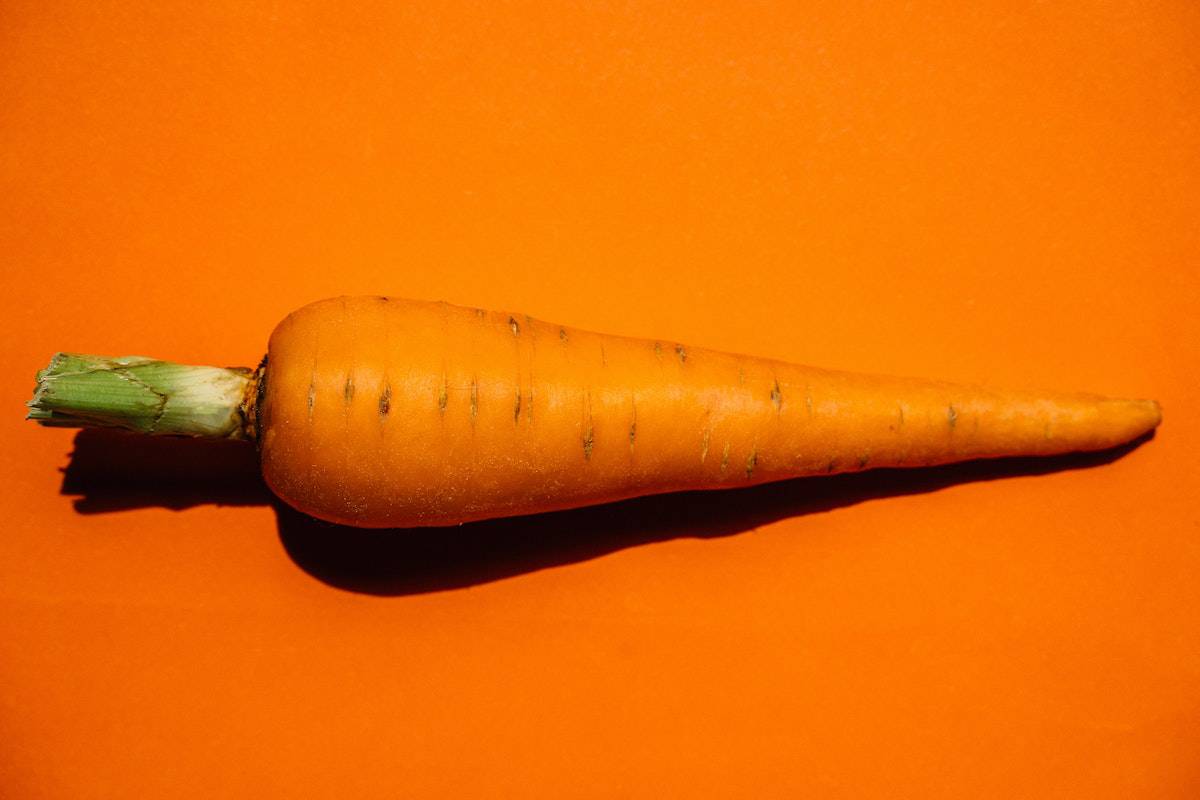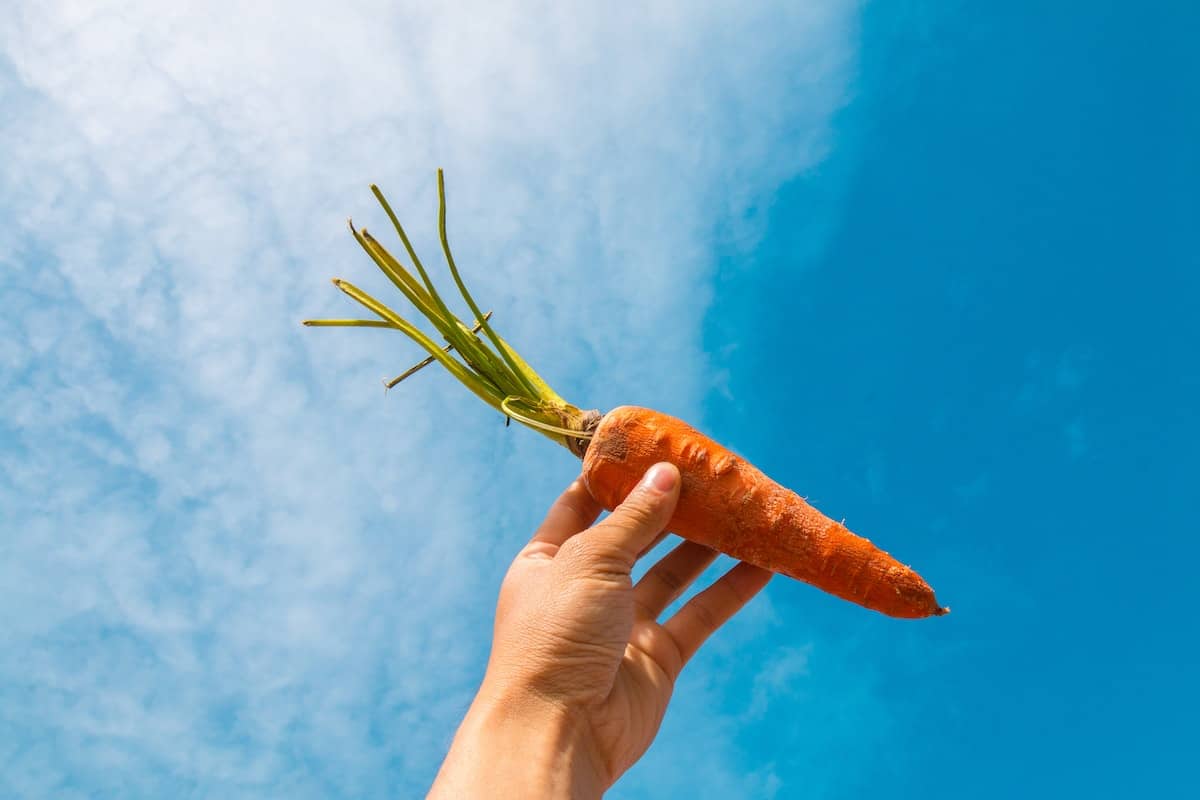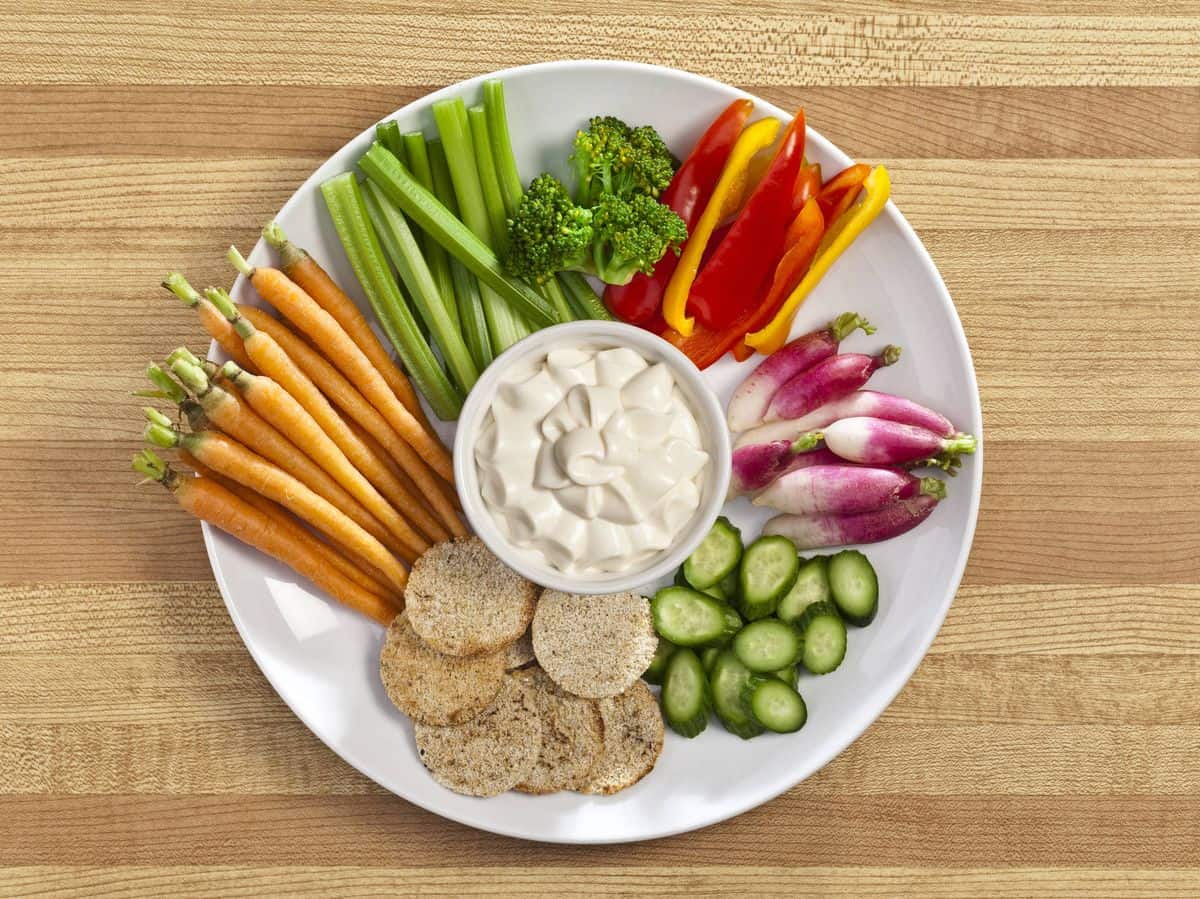In this article, we will discuss the nutritional composition of carrots and 10 benefits of eating raw carrots every day.
Additionally, we will comment on some options to include raw carrots in your diet and the culinary techniques that exist.
Main characteristics of carrots
The carrot, scientifically known as Daucus carota, belongs to the Apiaceae family. Its origin is in Central Asia, although it has spread to the temperate climates of Europe and tropical climates (1).
This plant is herbaceous in nature and needs two years to complete its life cycle, which is divided into two years (biennial). In the first year, its growth is vegetative, and the root develops in the form of a turnip.
At this time, they should be harvested for eating. In the second year, the plant uses the root’s reserves for flowering and seed production (1).
The carrot is presented as a thickened taproot of the original plant, whose characteristic color is orange. However, there may be other varieties ranging from purple to yellow.
It has the ability to accumulate the nutrients it needs to keep its aerial part rigid, which can reach up to 1.5 m in height. Additionally, it is worth noting that the stem presents an inflorescence of white or pink flowers (1).
There is a wild variety that cannot be consumed, with a rather hard and woody root. However, the cultivated variety is of great importance; in fact, the semi-long Nantes variety is the most cultivated in Spain (3).
Properties of carrots
Eating raw carrots provides a large amount of vitamin A, which is vital for proper vision.
According to the Nutritional Table of the Colombian Institute of Family Welfare (ICBF, 2015), raw carrots provide 700 retinol equivalents/100 g, while the cooked culinary form provides 2455 retinol equivalents/100 g (1). Therefore, carrots help us meet the daily nutritional requirements of vitamin A of 0.8-1 mg.
In 2018, the Spanish Nutrition Foundation (FEN), proposed that a daily consumption of a medium-sized carrot could cover the total vitamin A requirements for women between 20 and 39 years old, and 90% of the requirements for men of the same ages (1).
Additionally, eating raw carrots provides a large amount of water, as it is the most abundant component, around 88% of the total. Its characteristic orange color is due to the presence of provitamin A, which belongs to the carotene group. The most abundant carotene is beta-carotene (6,628 μg/100 g of edible portion), followed by alpha-carotene (2,895 μg/100 g of edible portion) (3).
Furthermore, among all its functions, thanks to the presence of vitamin E, it stands out for its participation in (2):
- Stability of blood cells
- Fertility
- Antioxidant action
Additionally, another nutritional property of eating raw carrots is the contribution of B vitamins (folates, vitamin B3 or niacin), as well as its notable contribution of minerals such as potassium, calcium, phosphorus, and iodine (2).
Nutritional composition
The following image shows a nutritional composition table in the case of eating raw carrots (3):
|
Per 100 g of edible portion |
Daily recommendations for men |
Daily recommendations for women |
|
|---|---|---|---|
| Energy (kcal) | 40 | 3000 | 2300 |
| Proteins (g) | 0.9 | 54 | 41 |
| Total lipids (g)
Saturated FA (g) Monounsaturated FA (g) Polyunsaturated FA (g) Cholesterol (mg/1000 kcal) |
0.2
0.037 0.014 0.117 0 |
100-117
23-27 67 17 <300 |
77-89
18-20 51 13 <230 |
| Carbohydrates (g) | 7.3 | 375-413 | 288-316 |
| Fiber (g) | 2.9 | >35 | >25 |
| Water (g) | 88.7 | 2500 | 2000 |
| Calcium (mg) | 41 | 1000 | 1000 |
| Iron (mg) | 0.7 | 10 | 18 |
| Iodine (µg) | 9 | 140 | 110 |
| Magnesium (mg) | 13 | 350 | 330 |
| Zinc (mg) | 0.3 | 15 | 15 |
| Sodium (mg) | 77 | <2000 | <2000 |
| Potassium (mg) | 255 | 3500 | 3500 |
| Phosphorus (mg) | 37 | 700 | 700 |
| Selenium (µg) | 1 | 70 | 55 |
| Thiamine (mg) | 0.05 | 1.2 | 0.9 |
| Riboflavin (mg) | 0.04 | 1.8 | 1.4 |
| Niacin equivalents (mg) | 0.6 | 20 | 15 |
| Vitamin B6 (mg) | 0.15 | 1.8 | 1.6 |
| Folates (µg) | 10 | 400 | 400 |
| Vitamin B12 (µg) | 0 | 2 | 2 |
| Vitamin C (mg) | 6 | 60 | 60 |
| Vitamin A: Retinol Eq. (μg) | 1346 | 1000 | 800 |
| Vitamin D (μg) | 0 | 15 | 15 |
| Vitamin E (mg) | 0.5 | 12 | 12 |
10 benefits of eating raw carrots
Below is a table with 10 properties and benefits that eating raw carrots would have for our body (1,2):
|
BENEFITS OF EATING RAW CARROTS |
|---|
| Its high water content allows us to consume it as a diuretic food, so it can participate in the fight against kidney stone problems and in weight loss. |
| Provitamin A, after absorption, is converted into vitamin A, promoting vision and proper functioning of the immune system. |
| The contribution of vitamin E helps to reduce the risk of cardiovascular, degenerative, and cancerous diseases. |
| The contribution of folic acid helps prevent anemia and spina bifida problems during pregnancy |
| It provides niacin (vitamin B, water-soluble), which participates in the proper functioning of the digestive system, nervous system, and energy production. |
| Eating raw carrots provides satiety due to its high fiber content, with few calories, which favors its consumption between meals. |
| Its high vitamin C content favors the elimination of skin spots, contributing to the maintenance of good skin condition. |
| Provitamin A is essential for the production of thyroid hormones that are involved in fetal growth and brain development. |
| It has vermifuge properties, that is, antiparasitic. |
| Eating raw carrots helps to combat aging, due to its high vitamin C content, providing brightness and the disappearance of wrinkles. |
Eating raw carrots allows us to keep their nutritional values intact, achieving a great number of benefits for our body.
How to add raw carrots to our dishes?
Eating raw carrots in a varied way is very easy if we consider some of these recipes (4):
Carrot crudité with yogurt sauce
Ingredients
- 2 carrots
- 2 celery stalks
- 2 cucumbers
- 8 endive leaves
- 2 unsweetened natural yogurts
- 25 g of mint or spearmint
- 2 sprigs of parsley
- 1 pinch of sugar
- 1 spring onion
- 1 pinch of chili (optional)
- 1 lemon
- salt and pepper.
Preparation method
First, we must wash the carrots, cucumbers, celery, and endive leaves, then peel the carrots, cucumbers, and celery to cut them into thin sticks.
Then, place the dry vegetables on a platter, where a glass for the yogurt sauce will also be placed.
To make the yogurt sauce, it is necessary to wash and chop the mint, peel and chop the spring onion, and mix them homogeneously with the lemon zest, chili, and parsley. Finally, in another container, add the yogurt, and add salt, pepper, and sugar.
Carrot and raisin salad
Ingredients
- 10 large carrots
- 2 cucumbers
- 1/2 cup of raisins
- 1 tablespoon of lemon juice
- 1/2 teaspoon of ground ginger
- 1 tablespoon of ground cinnamon
- 1 tablespoon of honey
- 3/4 cup of olive oil
- ground black pepper as needed
- 1/2 cup of sliced almonds
Preparation method
First, peel and grate the raw carrot. Slice the cucumber and mix it together to add the raisins.
Then, use a cup to prepare the dressing, which consists of mixing the lemon juice with the spices, olive oil, and black pepper. Beat all the ingredients.
Finally, pour the dressing over the salad and garnish with a few almonds.
How delicious it is to eat raw carrots like this!
Quinoa salad with avocado, boiled egg, turkey, and carrot
Eating raw carrots with seeds is also a very healthy way to add carrots to your dishes.
Ingredients
- 150 grams of quinoa
- Half an avocado
- 1 grated carrot
- 3 slices of turkey
- 2 boiled eggs
- Olive oil
- Salt
Preparation method
First, we must soak the quinoa and wash it several times until it is very clean. Then, we put it on medium heat for 15 minutes, and when it is cooked, we add cold water to stop the cooking.
Take a bowl and add the avocado, turkey, boiled egg, and grated carrot. Dress with oil and salt to taste.
It’s that simple, we already have our salad ready!
Culinary techniques for carrots
In addition to eating raw carrots, we can also consume them whole, chopped, grated, cooked, or in puree. However, various scientific studies state that it is not recommended to overcook carrots so that both their flavor and nutritional value remain intact or at least not significantly affected.
As one of the properties of eating raw carrots is that it requires a lot of chewing, it can also be consumed juiced for those who have chewing problems. Additionally, the juice is recommended to be consumed freshly squeezed.
Another aspect to consider when eating raw carrots is the preparation for consumption, as we must consider the following aspects (2):
- If we want to eat raw carrots, it is best to scrape them rather than peel them, as the vitamins are close to the skin.
- It is recommended to scrape and peel them just before eating raw carrots, as beta-carotene withstands heat but oxidizes easily.
- An indication that the carrot has been exposed to the sun too much is the appearance of green spots at the end of the root. Therefore, we must remove these areas to avoid bitter flavors.
Preservation of raw carrots
To eat raw carrots in good condition, it is necessary to consider some conditions for their preservation (2):
- Clean the surface of the carrot without using water.
- Avoid storing them with apples, bananas, melons, or peaches because they produce ethylene derived from their ripening processes, giving a bitter taste to the carrots.
- Store them in a cool and airy place.
- Store for 2-3 weeks in the refrigerator.
Bibliographic references
- Galindo-Pacheco, J. R. (2020). Carrot (Daucus carota L.) Technical recommendations manual for its cultivation in the department of Cundinamarca.
- Vilaplana Batalla, M. (2004). Vegetables and greens. Offarm, 23(2), 120–132.
- Varela-Moreiras et al. (2018). The Spanish diet. Nutritional characteristics of the main foods in our diet. Food Composition Tables. Spanish Nutrition Federation.
- García, R. (2020, February 13). Ideas for eating raw carrots besides crudité. Revista Mía.






